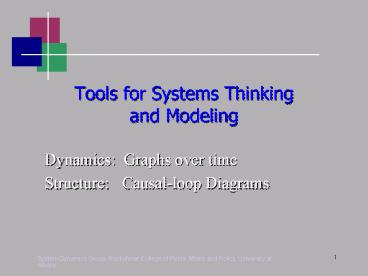Tools for Systems Thinking and Modeling
1 / 38
Title:
Tools for Systems Thinking and Modeling
Description:
System Dynamics Group, Rockefeller College of Public Affairs and Policy, University at Albany ... Deliberately blur discrete events into ... Jon's suspicion (R) ... –
Number of Views:113
Avg rating:3.0/5.0
Title: Tools for Systems Thinking and Modeling
1
Tools for Systems Thinkingand Modeling
- Dynamics Graphs over time
- Structure Causal-loop Diagrams
2
A Systems Perspective
Reactive
Events and Decisions
Adaptive
Increasing leverage
Generative
3
Distancing...
- A systems view stands back just far enough to...
- Deliberately blur discrete events into patterns
of behavior - Deliberately move from a focus on individual
decisions to a focus on policy structure
4
The Systems Perspective
Reactive
Events and Decisions
Adaptive
Increasing leverage
Generative
5
Dynamic Thinking
- Define problems in terms of graphs over time.
- Graph important variables
- Graph historical data
- Graph anticipated dynamics
- Graph preferred dynamics
- Use these to focus systems thinking and modeling
6
Unemployment ()
7
New York City Populations
8
Percentages of high school grads completing
college, by ethnicity
9
Unemployment Welfare in Dutchess County, NY
Welfare roll
Unemployment
10
New York State K-12 Public Education Expenditures
per Pupil
11
Strive for Dynamic Insights
Heres where we went wrong...
12
So youre getting more education
Income
Time
13
The Systems Perspective
Reactive
Events and Decisions
Adaptive
Increasing leverage
Generative
14
System Structure
- Accumulations
- AKA Stocks
- Accumulations are both tangible and intangible
- Resources, populations
- Preferences, feelings, pressures, perceptions
- Causal structure feedback loops
- Delays
- Policies governing decisions
15
Causal Diagrams
- Causal mapping is a powerful tool for
representing structure in complex systems.
- Arrows indicate causal influence.
16
Polarities of Causal Links
- Positive and negative signs show the direction of
causality
direct relation inverse relation
17
Definitions of Link Polarities
- An increase in A makes B greater than it would
have been without the change a decrease in A
makes B less .
An increase in C makes D less than it would have
been without the change a decrease in C makes D
greater.
- All words phrases are expressed as quantities
that have a clear sense of increase or decrease.
- No verbs the action is in the arrows.
18
Examples
Higher test scores mean more support lower
scores, less support.
More teachers mean smaller classes smaller
classes mean more learning. Fewer teachers would
mean larger classes and less learning.
Ceteris paribus... All other influences held
constant as we assign polarities.
19
Feedback Loops
- A feedback loop exists when decisions change the
state of the system, changing the conditions and
information that influence future decisions.
20
The Joy of Feedback
21
The Joy of Feedback
22
No its more like the life cycle of the famous
scientist
23
Examples of Feedback Loops
24
Two kinds of feedback loops
- Reinforcing loops
- self-reinforcing
- growth producing
- destabilizing
- accelerating
- even number of s
- Symbolized by
- Counteracting loops
- balancing
- goal seeking
- stabilizing
- compensating
- odd number of s
- Symbolized by
25
Examples of Reinforcing Loops
-
-
26
Reinforcing Feedback in the Newspaper
27
Reinforcing Feedback in the Newspaper
28
Reinforcing Feedback in the Newspaper
Garfields happiness
Jons suspicion
(R)
29
Examples of Balancing Loops
-
30
What are these loops, and what stories do they
tell?
-
-
31
Tips for Determining Link and Loop Polarities
- For each link, determine the effect of an
increase in the variable at the tail of the
arrow - If the variable at the head increases, assign a
plus. - If the variable at the head decreases, assign a
minus. - For each loop, count the number of negative
signs - An even number of negative links is a reinforcing
(R) loop. - An odd number of negative links is a balancing
(B) loop. - Most important For each loop, tell a
self-reinforcing or balancing/counteracting
story, and check that the story matches the loop
polarity.
32
Linking Feedback Structure and Dynamic Behavior
- Linking causal loop thinking with graphs over time
33
World Population (billions)
8
6
4
2
0
1500
1600
1700
1800
1900
2000
34
Self-reinforcing processes in world population
growth
35
Typical Reinforcing Loop Behavior
Lets assume a tax increase. What will the graph
look like?
Businesses and taxes loop in a reinforcing decline
36
Typical Counteracting Loop Behavior
37
Typical Counteracting Loop Behavior
38
Summary of Structure and Behavior
- Reinforcing loops are responsible for
accelerating growth, accelerating decline, or
traps due to inertia - Counteracting loops are much more prevalent but
often less obvious they balance and adapt - Counteracting loops can compensate for policy
initiatives and defeat intended effects - Combinations of reinforcing and counteracting
loops are responsible for all the complex
dynamics we create in our complex systems.






























